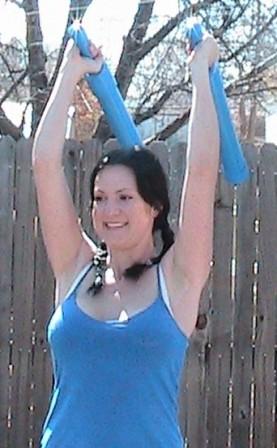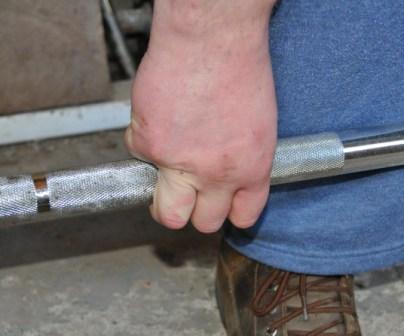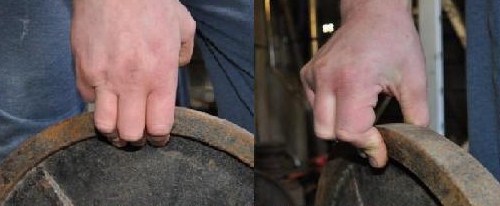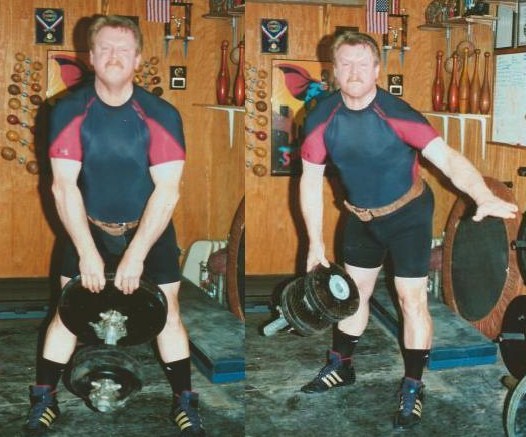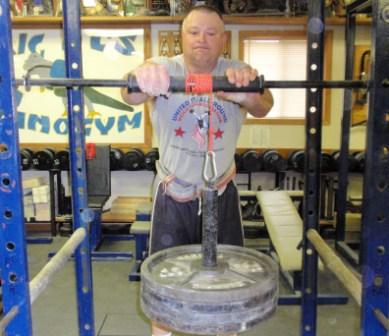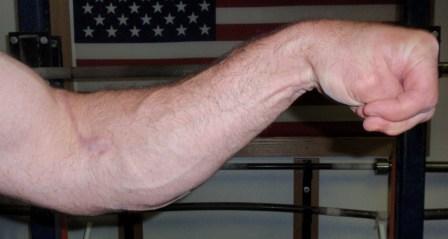Thom Van Vleck’s “Get a Grip” Tips
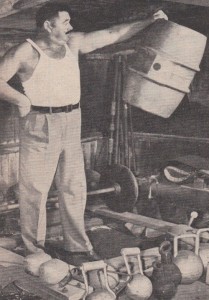
While Mac Batchelor had huge hands, he also developed them with many different implements and techniques.
by Thom Van Vleck
This is my entry in the DB Walk 3.5″ handle contest! I like my odds better this time with so many winners. But honestly, me writing about grip training is a bit like a fat guy telling you how to diet!
A great grip has eluded me in my 34 year lifting career. Sure, there are things that I do better than others, like the pinch grip. I have also never lost a deadlift in a contest due to grip. But the reality is that I have small hands for my size and a strong grip never came naturally to me. So maybe you could consider me the “hardgainer” when it comes to grip and maybe that makes me more of an expert than I thought. After all, they say mediocre players make the best coaches. The best athletes generally don’t make good coaches because everything came naturally to them.
As a result, I’ve read a great deal about grip training. I would recommend any of John Brookfield’s books on grip training. I have also got to train with two of the best short steel benders in the world, John O’Brien and Brett Kerby. So, most of this comes from those experiences but I will end with one tip that I came up with on my own, so hopefully you will get at least one original idea out of this!
1. Specify
Over the years my focus has changed in the strength world. I have competed in Olympic lifting, Powerlifting, Strongman, USAWA All-round, and my passion for the last 15 years has been Scottish Highland Games. All require grip strength and lots of different types of grip strength. If you are going to do a bench press meet you don’t just work Behind the Neck Presses, you work the Bench Press and all the muscles specific to that event! Don’t just throw in some wrist curls at the end of your workout. Train your grip specifically for how you are going to need it. This doesn’t mean you find one grip exercise and work it to death. You need to get some books, read some articles, talk to some good grip guys and get a list going and keep track of what you think works for you. If you came to my gym I could show you over 100 grip exercises to do and all of them I have done myself at one time or another. In the process, I have figured out what works for me and for the specific event I need it for!
2. Training
Try to quantify your workouts as much as possible so you can be progressive. Don’t just take a weight and do it every workout, it’s PROGRESSIVE resistance that’s key. Keep some magnets around to add fractions of pounds. Get some fractional plates or the “poor boy” method is go to the tractor supply and get some large washers that will fit on a 1″ bar, two of them will weigh from 1/4 to 1/5 of a pound. Get enough to supplement your 2 and 1/2lb plates and if you can, get some 1 1/4lb plates. You need to be able to add fractions of weight to any implement and push yourself. Plan your workout, set goals, cycle your grip training just like you would for any contest, including giving it a break from time to time.
3. Mental Aspect of Grip
I think Grip training is more mental than most any other kind of training. I have watched John O’Brien and Brett Kerby grimace in pain doing the short steel bending and having folded a 60 penny nail a few times….it just hurts! Your hands are full of nerves and that is why. Sure, Squats are hard, but your hands will hurt! So, there’s a mental aspect to this that needs to be overcome. I saw John O’Brien drive a 60 penny nail deep in his hand and he still finished the bend and did three more shows that same weekend. Most grip guys have mastered pain. Working you grip requires pain tolerance and can also teach it! Brett told me that his hands have hurt so bad he thought he’d seriously injured them. It’ll hurt….get over it.
4. Just One Original Thought
Ok, let’s see if I can impress you. Most of what any of us knows about anything we learned from someone else. Here is something I came up with on my own (but that doesn’t mean someone else didn’t come up with it first). I noticed that when I trained my grip, everything involved my elbow being bent. I also noticed that most everything that I needed a great grip for involved my elbow being locked out (throwing, deadlifting, cleaning, etc.). So, I spend a lot of time working my grip keeping my elbow locked out. This usually involves hanging from a bar and squeezing the bar for reps (hanging from a bar has the added benefit of tractioning your back). It also means that whatever grip exercise I’m doing, I try and get myself in that “lockout” position and if possible, with my arm being stretched to get used to gripping as hard as possible with my arm straight and under tension.
So, those are my grip tips. I hope you have gained some knowledge that will help you “get a grip” on your next contest!
